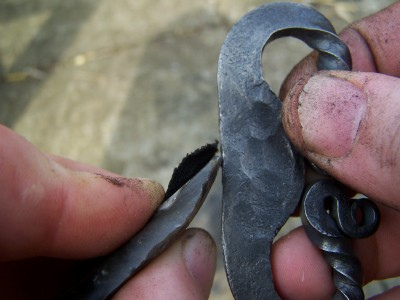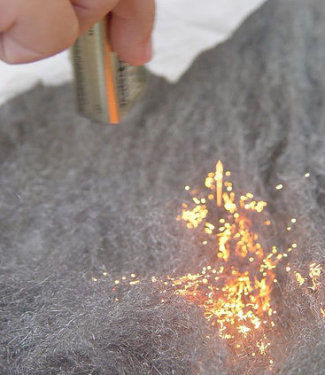If you’re a perfume junkie but tired of wearing the same scents as everyone else with access to Bloomingdales, maybe it’s time you learned to make your own bottle of perfume. The good news: it’s really easy to do and if you already know what your favorite ingredients are, you’re set. The mildly annoying news: the ingredients you use and the amount therein can change a perfume from amazing to awful in a snap. Making your own perfume is all about patience and experimentation… but if you like playing mad scientist/alchemist and you’re dedicated, then it’s really quite a lot of fun.
The Basics: Here’s where your childhood piano lessons come to use
All of the lovely smells dancing in your head right now – rose, lilac, orange, musk – those are called notes. You know how snooty people take a sip of wine and swirl it around their mouth before spitting it out and being all like, “It has a hint of cherry and tastes of the soil of the Burgundy region” (confession: I go to wine country a lot) – well that’s kind of similar. The notes you smell all work together to make up a chord. A chord is composed of a base note, a heart note, and a head note. The base note is the one that lasts the longest and is usually something like vanilla or sandalwood. The heart note is the middle note which is generally floral. The head note is exactly that – a heady, strong smell that hits you right out of the bottle. One or more chords make up the composition (formula) of the perfume. So in non-musician speak let’s say you have sandalwood, jasmine, and orange. That is one chord – sandalwood is the base, jasmine the heart and orange the head.
Your head note is the most fleeting as they have an explosive scent and evaporate quickly. Over time, you will notice the scent changes – melts even – into the heart and base notes. It’s very subtle and beautiful when you think about it.
How do you pick the right oils to go together?
That really depends on you. What kind of perfume do you go for? Woodsy, citrus, floral, musky? My
completely scientific process of choosing oil combinations starts by me imagining what certain famous people would have worn. Marie Antoinette was a straight up flower. Queen Elizabeth I had migraines so I stick to marjoram. Think about the scents you like and pick a few based on that. Here are some ideas:
Woodsy: Cedarwood, Pine, Sandalwood
Floral: Jasmine, Rose, Ylang Ylang
Fruity: Grapefruit, Orange, Bergamot
Earthy: Vetiver, Musk
Herbal: Rosemary, Lavender, Chamomile
Spicy: Black pepper, Clove, Ginger
Sugary: Amber, Vanilla
A few more tid-bits of info before we get started
Order matters people! Once you have decided which ingredients will comprise your base, head and heart notes, make sure you add base first, heart second and head last.
For today’s lesson, we will be making a 5ml bottle of perfume oil. Perfume oil is my favorite right now because it contains no alcohol, just skin loving Jojoba or Sweet Almond Oil – your preference. These are lean in closer perfumes as opposed to the heady fill the room type – especially amazing if you are headache prone like me. Perfume oils are also more bang for your buck because they can last anywhere between 5-12 hours depending on the strength of the ingredients you use. Compare that to eau de parfum (the regular alcohol based perfume you will find in stores) that lasts 2 hours if you’re lucky. Also, no one likes the old lady who goes crazy with the rose water.
The Maths. (Sorry)
In a cruel twist of fate, the artistry of perfumery requires the use of a lot of math. Not hard math mind you, but.well.it’s.math. (I was an English major, I recoil at numbers). Every milliliter of liquid is roughly 20 drops with a pipette or glass dropper. As I stated earlier, today’s lesson is for a 5ml bottle of perfume. Sooo:
5ml X 20drops = 100 drops total
So you will have 100 drops of liquid in your bottle. The ratios of the notes are as follows:
2 parts base : 1 part heart : 1 part head : Rest is carrier oil (Jojoba, Sweet Almond, etc)
There is a huge range of concentration levels that vary across perfume brands. Generally perfume oils will have a 20 - 80% concentration of essential/fragrance oils to carrier. Let's say you want to have a nice light perfume that is 20% fragrance. 20% of 100 drops is 20 drops. This means that your fragrance combination will amount to 20 drops and the remaining 80 drops will be carrier.
Since we have 100 drops to account for and we now know the ratios, here is the formula we will be working with:
10 drops base + 5 drops heart + 5 drops head + 80 drops carrier oil = 100 drops
We did it! We survived the maths! Ok, now the fun can actually begin!
***Keep in mind, that is a basic super easy way of dividing up the oils. Generally, once you've figured out your ratio / drop number, you don't have to follow that to a T. You could have 12 drops base, 5 drops heart, and 3 drops head if you want to. It's really dependent on the strength and smell of your oils and you generally want more base and heart than head. This is all about experimentation.***
What You Will Need

Your supplies should look something like this
1 – 5ml bottle, preferably with roll on ball; you can order online or go to your local health food store and pick up an amber vial or dropper bottle.
3 essential oils or fragrance oils depending on what you want. If you want all natural perfume, only use essential oils. Fragrance oils can contain synthetics but have already been diluted in carrier oil so they tend to be less irritating. When choosing essential oils, make sure to look up any health advisories they may have as not all EOs are skin safe.
Brambleberry has a nice, affordable selection of both EOs and fragrance oils.
4 pipettes or glass droppers; 1 for each EO and 1 for the carrier
Jojoba or Sweet Almond Oil.
Trader Joe’s has a nice Jojoba in their spa section that is both affordable and great for dry skin beyond your perfuming needs.





















 Photo by
Photo by 











0 comments:
Post a Comment